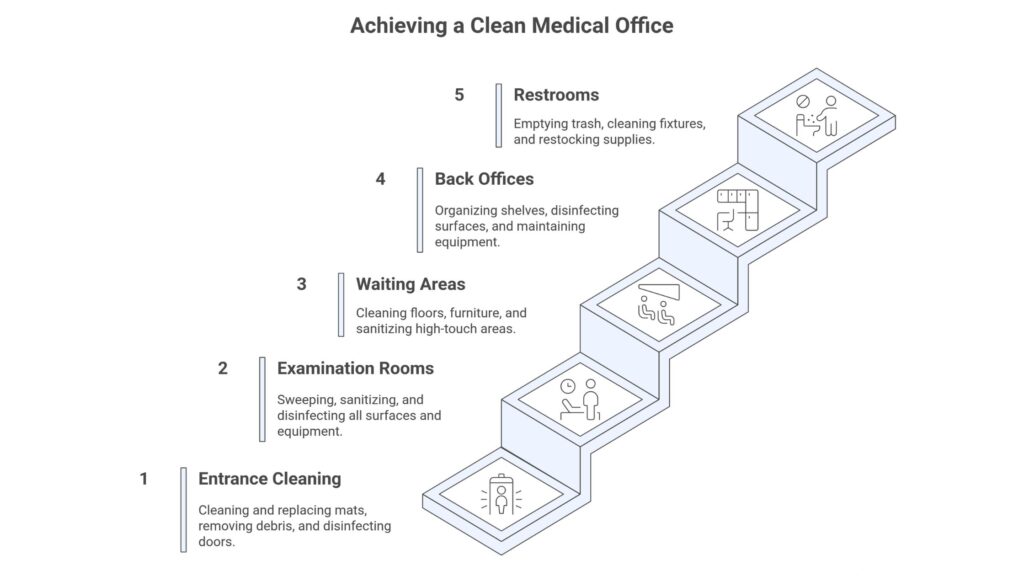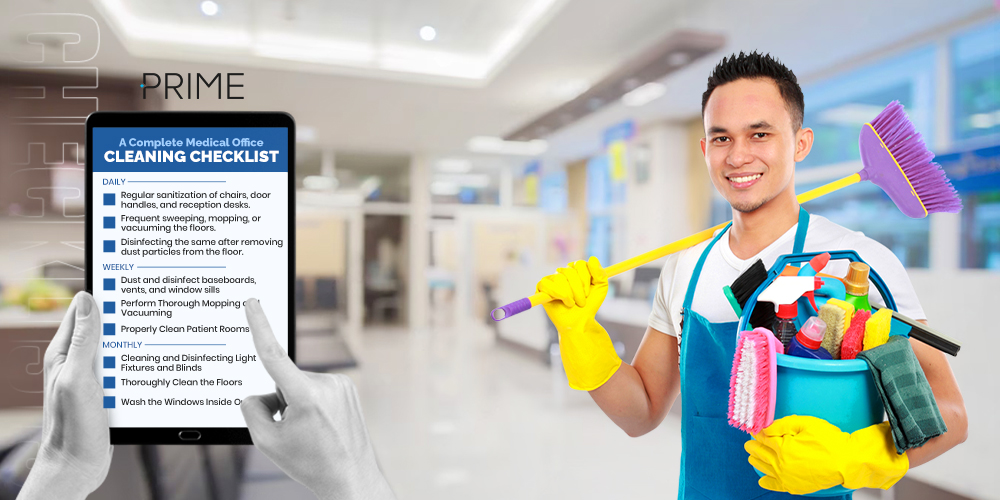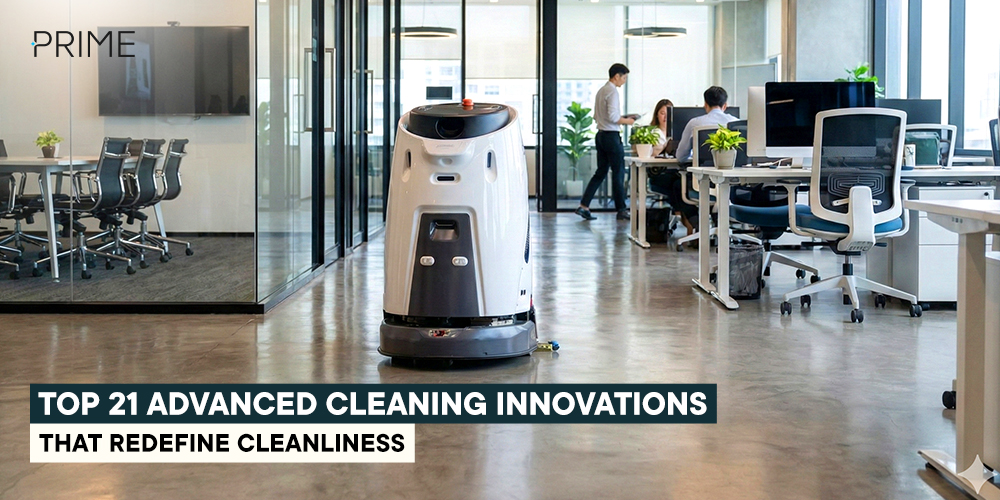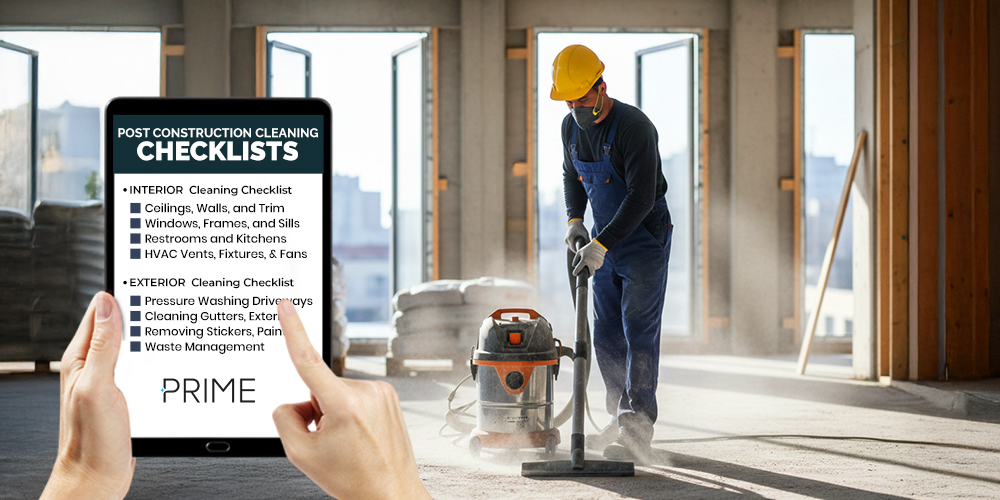Ensuring the cleanliness of medical offices is crucial. A medical office is a facility where patients seek medical care and treatment.
People walk in and out of medical offices on a regular basis. They are bustling with activities. Hence, taking care of the facilities is paramount.
Since so many people visit medical offices, the foot traffic is likely to be high. The increased foot traffic can spread viruses and other disease-producing agents.To minimize the risk of disease-causing elements, the government has also sanctioned regular maintenance and sanitation of medical facilities and offices.
What are the areas to consider when cleaning medical offices? Well, every corner of the space should be spotless and well-maintained.
Not only does a clean medical office enhance the space’s appearance, but it also creates a more professional environment. A medical office cleaning checklist will include the activities and equipment necessary for maintaining the spaces.
Medical offices are professional establishments that require thorough cleaning. From office exteriors to waiting lounges and restrooms, ensuring full-on cleaning is a must.
Since these establishments focus on patient recovery, following strict cleaning protocols is essential.
With reliable cleaning services, medical offices can retain their tidy and hygienic environment. This blog will provide a detailed cleaning checklist for medical offices.
Let’s have a look!
Key Takeaways
- Medical offices are spaces designed for healthcare practices. Numerous people seeking medical treatments frequent the space daily.
- Cleaning and sanitation of these buildings are of utmost importance as they promote patient recovery.
- Professional cleaners follow a healthcare facility cleaning checklist. It fosters patient safety and their overall well-being.
- Even for staff members, a clean medical facility enhances their overall well-being.
Why Cleaning Is Essential in NYC Medical Offices?
Places where you conduct medical practices and evaluations require consistent cleaning. Medical offices are breeding grounds for germs, contamination, and disease-spreading bacteria.
The reason is obvious. People who are already sick mostly visit medical facilities and offices. Thus, to minimize the risk of spreading diseases, you should consider seeking medical cleaning services in NYC.
A professional cleaning service will follow medical office cleaning procedures to maintain the place’s hygiene.
There are various reasons why cleaning is essential in NYC medical offices:
1. Cleaning a medical office will prevent the spread of germs and infections that are already present, as it is a place frequented by patients.
2. Professional cleaning agents utilize specialized tools and techniques to perform thorough cleaning in medical offices.
3. A tidy healthcare center will protect staff members and vulnerable patients from contracting diseases.
4. NYC medical offices should maintain cleanliness as a part of professionalism.
5. Moreover, patients are likely to visit a medical office that is serious about cleanliness and organization. It makes them feel comfortable, and they put their trust in the place of recovery.
Key Areas to Consider in Medical Offices

A medical center cleaning checklist will include the core areas. These are office exterior, waiting areas, restrooms, back offices, and examination areas.
Hiring medical cleaning services ensures keeping these areas super clean and shiny. It will also promote the wellness of their staff, who work tirelessly to care for the patients.
A medical practice cleaning checklist will give a complete guide on how to clean these areas:
1. Office Exteriors
- Cleaning the entrance and exit door mats. Replacing the worn-out mats with new ones for a better appearance.
- Professional cleaners will take care of the trash and debris from the medical office premises.
- Consistent sweeping and removal of dirt from places with maximum foot traffic.
- Cleaning service agents will carefully wipe down entrance doors and disinfect doorknobs.
- Disposing of medical office waste correctly. The cleaners will separate hazardous and non-hazardous waste.
- If there’s stagnant water in the walkways, cleaning agents will wipe the water to avoid accidental falls.
2. Examination Rooms
- Sweeping, mopping, and scrubbing the floors of the examination rooms.
- Cleaning and sanitizing doorknobs and name plates.
- Discarding waste from the trash cans and sanitizing them.
- Wiping down and disinfecting the walls.
- Cleaning and disinfecting every part of the examination rooms, such as beds, counters, and tables.
3. Waiting Areas
- Wiping the floors and cleaning all furniture, such as magazine racks, tables, chairs, and sofas.
- Regularly changing the air filters in air conditioners keeps clean air circulating in the medical office.
- Sanitizing the usual spots that people mostly touch, including handrails, door handles, and light switches.
4. Back Offices
- Properly cleaning and organizing all shelves, storage areas, and cabinets.
- Disinfecting doorknobs, light switches, and handrails.
- Cleaning and sanitizing collaborative spaces, such as break rooms and conference rooms.
- Wiping the dust from the workstations and cleaning them properly.
- Keeping the office equipment in working order.
5. Restrooms
- Emptying the trash cans of waste.
- Inspecting air vents and cleaning them.
- Mopping, disinfecting, and drying the floors.
- Cleaning and sanitizing sinks, toilets, and urinals.
- Restocking essential consumables, including hand soap, toilet paper, and paper towels.
Complete Medical Office Cleaning Checklist
According to various studies, a clean medical office environment significantly reduces the risk of healthcare-associated infections. Further, patients trust a medical office that maintains a tidy and sanitized environment.
Not to mention, a pristine medical facility promotes patient and staff safety, reflects professionalism, and boosts overall confidence.
You can follow a medical office cleaning checklist template for the daily, weekly, monthly, and annual maintenance of your medical office.
Daily Cleaning Checklist for Medical Offices
Daily cleaning of medical offices focuses on the high-traffic areas. It is crucial to maintain the cleanliness and hygiene of the following areas, thereby ensuring patient trust.
Walkways, entrances, and waiting rooms are the most frequently visited areas in a medical office. The following are the tasks that cleaners will perform in these spots:
- Regular sanitization of chairs, door handles, and reception desks.
- Frequent sweeping, mopping, or vacuuming of the floors.
- Disinfecting the same after removing dust particles from the floor.
- Wiping down the windows and doors to create a welcoming environment.
Examination rooms also require daily cleaning. Here are some tips to help you keep the space fresh and neat.
- Use EPA-approved disinfectants to sweep and mop the examination room floors.
- Remove the trash from the bins and sanitize them.
- Sanitize high-touch areas of the exam rooms, such as equipment, countertops, and tables.
Medical office staff members access back offices and break rooms. At the same time, they also deal with patients suffering from various illnesses.
Ensuring the well-being of staff members is a priority. Here’s the medical office cleaning checklist for these spaces:
- Clean kitchen appliances, such as the refrigerator and microwave.
- Sanitize shared surfaces, such as tables, kitchen countertops, and desks.
- Empty and disinfect the recycling bins and trash cans.
Restrooms of a medical office are also a common area that requires daily cleaning. Below are the ways to keep the cleanliness of the medical office restrooms in check:
- Mop and sanitize the restroom floors. Don’t leave the corners unchecked.
- Restock toilet paper, paper towels, hand soaps, and other consumables.
- Sanitize restroom fixtures, including sinks, counters, toilets, and urinals.
Weekly Cleaning Checklist for Medical Offices
For the weekly maintenance, a deep cleaning service is crucial in a medical facility. The following tasks should be considered for a clinic or any other medical facility.
1. Dust and disinfect baseboards, vents, and window sills: Use EPA-approved disinfectants and microfiber cloths to wipe down these areas.
2. Perform Thorough Mopping and Vacuuming: To accumulate dust particles, use HEPA filter vacuums. After that, use appropriate disinfectant solutions to mop the corners and edges.
3. Properly Clean Patient Rooms: Deep clean all surfaces in the patient rooms. Sweep and mop surfaces under the furniture. Furthermore, use clinic-grade sanitizers and disinfectants to clean walls, exam tables, and other less visible areas.
Monthly Cleaning Checklist for Medical Offices
There are certain monthly cleaning activities essential in a hospital, clinic, and medical office. These monthly cleaning tasks involve:
1. Cleaning and Disinfecting Light Fixtures and Blinds: Use a damp microfiber cloth to remove dust and grime from the light fixtures of the medical office. Take the blinds off and soak them in a mild cleaning solution.
2. Thoroughly Clean the Floors: Sweep, mop, and vacuum. Use floor strippers to remove the old wax from the flooring. After that, use fresh wax to retain the shine of the flooring.
3. Wash the Windows Inside Out: Protect the natural shine of the window interiors and exteriors. Use zero-streak cleaning agents and squeegees to wipe down the dust and grime from the windows. Look for accumulated dirt in the window tracks and clean them using damp clothes.
Annual Cleaning Checklist for Medical Offices
In addition to daily, weekly, and monthly cleaning of medical offices, consider annual maintenance of the facility.
The change in season accounts for the flu season. That means numerous patients will seek medical assistance from healthcare practitioners.
The annual cleaning of medical offices involves:
- Cleaning and sanitizing air vents.
- Deep cleaning upholstery and carpets.
- Replacing old air filters with new ones.
- Training employees on disposing of biohazard wastes and following the protocols.
- Conducting a thorough disinfection audit.
What Equipment is Required for Cleaning Medical Offices?
A doctor’s office or clinic experiences high foot traffic because patients and staff are always on the move.
From a clinic cleaning checklist, you will learn about the equipment and supplies used in the cleaning process.
It is not very usual to see an untidy and cluttered clinic or doctor’s office, as it questions the professionalism of the place.
It is therefore important to use the necessary equipment to maintain a clean and safe environment for everyone.
1. Vacuum Cleaners
Vacuum cleaners are essential cleaning equipment in a medical office. Cleaning agents utilize this equipment to collect dust from high-traffic areas of a medical facility, such as walkways, waiting rooms, and entrances.
Since clinics and other medical facilities are often hotspots for germs and diseases, using vacuum cleaners equipped with HEPA filters can be beneficial.
2. Cleaning Rags
Every corner of a medical facility should be super clean and organized. With the help of rags, cleaners can wipe dust from windows and doors. Cleaning rags come in different hues and sizes. For different surfaces, you can color coordinate the rags.
3. Glass Cleaners
A clinic or a doctor’s office will have various glass surfaces, ranging from tables to windows and mirrors. Professional cleaning services utilize glass cleaners to remove stains and dirt from surfaces.
4. Disinfecting Wipes
A convenient medical office cleaning supply is disinfecting wipes. They are convenient to use. After performing vital cleaning processes, use the wipe to remove dust and disinfect the surfaces.
Disinfecting wipes are best suited for hard surfaces, light switches, countertops, and doorknobs. These supplies are most useful in patient rooms, doctors’ cabins, and restrooms.
5. Hospital-Grade Laundry Detergents
Laundry detergent is a must in medical facilities. Cleaners use hospital-grade laundry detergents to wash patient gowns, used bed sheets in exam rooms and patient rooms, as well as hand towels. These detergents are stronger than regular detergents and are proven to kill viruses and bacteria.
Importance of a Medical Office Cleaning Checklist
Cleaning a clinic or medical office is imperative as it is the same space that promotes well-being. However, starting the cleaning process can be a daunting task.
Following a medical clinic cleaning checklist will ensure regular sanitation while reducing the risk of infections and diseases.
Professional cleaners follow a detailed checklist when cleaning medical offices to cover every area.
Reduces the Risk of Infections
Reviewing a doctor’s office cleaning checklist can help reduce the risk of spreading infections and cross-contamination. With a cleaning checklist, medical facilities can foster a safe and welcoming environment for patients and staff members.
Ensures Consistency
A checklist enables medical facilities to thoroughly maintain high-traffic areas. These include waiting rooms, doctor’s chambers, exam rooms, back offices, and hallways.
Training Tool
A medical office cleaning checklist can work as a template for newer cleaning staff. The new cleaning individuals can use this valuable resource to clean the surfaces properly.
In addition, a checklist for medical office cleaning includes protocols that cleaning professionals will adhere to, ensuring every corner remains fresh and virus-free.
Creates a Positive Impression
Everyone expects to step into a medical office that is spotless. It gives patients the impression of a well-maintained and sanitized environment. As a result, patients seeking medical treatment will place their trust and confidence in the facility or clinic.
Key Steps to Clean a Medical Office
Regardless of whether you use an outpatient facility cleaning checklist, you need to follow certain procedures and steps to maintain the cleanliness of the office.
The maintenance of a medical office is not something to compromise at any cost. The steps are quite simple and easy to follow:
1. Use clinically approved cleaning products
As medical facilities are sensitive spaces where patients come and go frequently, it is crucial to be critical about the cleaning products used. Use EPA-approved cleaning supplies to disinfect all the areas.
2. Wear gloves while performing the cleaning tasks
Hospitals are epicentres for infections. While cleaning, ensure that the cleaning agents are using gloves to minimize the risk of cross-contamination.
3. Clean air ducts and use HEPA filters
The next step in medical office cleaning is to clean the air ducts. Use HEPA filters to collect the dust and dispose of it carefully in the trash cans.
4. Sweep, mop, vacuum, and disinfect
Regularly sweep the floors of the medical facilities. Following that, mop and vacuum the floors. To reduce the risk of disease-spreading germs, use strong disinfectants.
5. Leave no corners overlooked
Use effective cleaning equipment, such as vacuum cleaners and rags, to remove dust from the most inaccessible areas of the medical office. From exam rooms and waiting rooms to back offices and collaborative spaces, ensure every area is clean and organized.
6. Final Inspection
After cleaning is complete, take a final look at the medical office for any final touch-ups.
Important Considerations for Medical Office Cleaning
When cleaning a medical office, there are several important factors to consider. Various free medical office cleaning checklist templates list the considerations. The common factors are:
- When there’s a change of season, medical offices will demand a deep cleaning service. The service removes dust and allergens from areas that are not regularly cleaned.
- The effects of the pandemic are still not forgotten. It is thus specifically vital for medical offices to pay utmost attention to cleaning and maintenance.
- Moving to a new medical office will require thorough cleaning. The shift can be challenging, hence professional cleaning services are the best way to maintain the spaces.
- If there’s an accidental spill related to hazardous substances, professional medical cleaning agents can help you with the situation.
Benefits of Hiring Professional Medical Cleaning Services
Medical facilities should prioritize cleanliness and maintenance. However, there are a few that don’t follow the cleaning protocols. To avoid having your medical office shut down, hiring professional medical services can be an effective solution.
The following are the benefits of hiring professional medical cleaning services:
1. When you hire professionals to clean your medical office, understand that they are experts in maintaining the cleanliness of these spaces. Hence, they will make your place shiny and welcoming in a given time frame.
2. Seasoned cleaners understand the importance of a well-maintained medical facility. They utilize several medical devices and clinically proven products to clean the various areas. Using such products and equipment will reduce the spread of germs and diseases.
3. Government health agencies set strict regulatory policies regarding the cleanliness of medical offices. Professional cleaning services are well-versed in such policies and protocols and perform the necessary activities accordingly.
4. Cleaning agents specialize in maintaining healthcare environments and have extensive knowledge about the products and equipment used in the process. To ensure proper cleaning of medical offices, hiring medical cleaning services is a suitable option.
Make Your Medical Office Spotless and Germ-Free!
It is needless to say the importance of a clean and well-maintained medical office. By following a medical office cleaning checklist, you can elevate the appearance and ambience of the space.
A thoroughly cleaned medical office is a reflection of professionalism. Also, it creates a welcoming environment that patients can trust. Consider using proper cleaning solutions and equipment to perform the maintenance tasks.
Medical office cleaning requires following various protocols. It can be a daunting task for you to keep up with the cleaning procedures. Hence, hiring professional cleaners is an effective measure.
At Prime Cleaning Services, we offer reliable cleaning partners who understand the specific maintenance needs of your office space. We tailor our commercial cleaning services to your specific needs.
Cleaning agents utilize high-tech equipment and standard cleaning supplies to maintain a safe and healthy environment for everyone.
Browse through our cleaning services to make your space organized and welcoming.
Frequently Asked Questions
1. How often should the medical office be cleaned?
Patients seeking medical treatment visit medical offices frequently. The place is thus the breeding ground for diseases. For this matter, it is essential to regularly clean the medical office.
2. What disinfectant is frequently used in the medical office?
Healthcare facilities usually use stronger disinfectants. Their purpose is to kill disease-spreading viruses and bacteria. The commonly used disinfectants in medical offices are hydrogen peroxide, chlorine & chloride compounds, phenolics, and peracetic acid.
3. What cleaning solution would you use for the medical office?
Any cleaning solution that is effective against pathogens and caters to the janitorial medical office cleaning checklist will be suitable for such settings. You can use hydrogen peroxide to clean the space, reducing the risk of diseases and contamination.




